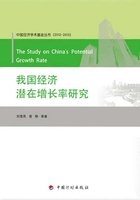
二、理论模型
(一)模型简介
本章使用的模型是一个小型DSGE模型。通过代表性家庭的跨期决策来推导出新凯恩斯IS曲线;生产市场假设存在完全竞争的最终产品市场和垄断竞争的中间产品市场,中间产品市场的价格调整存在调整成本因而推导得到新凯恩斯菲利普斯曲线;货币政策规则刻画了货币政策当局如果通过调整货币供应量增长率来应对通胀和产出增长变动。
(二)代表性家庭
代表性家庭的偏好由下面的预期效用方程给出:

其中,β为折现因子,at为偏好冲击,Ct为t期的实际消费,![]() 为t期的实际货币余额,ht为劳动供给量,φt为劳动供给偏好冲击。
为t期的实际货币余额,ht为劳动供给量,φt为劳动供给偏好冲击。
其中,偏好冲击和劳动供给偏好冲击遵循下列一阶自回归过程:

自回归系数0<ρa<1和0<ρφ<1,ε at和ε φt服从均值为0、标准差分别为σat和σφt且序列无关的正态分布。
家庭的预算约束为:

其中,Pt为t时期的价格总水平,Tt为货币政策当局对家庭的一次总支付的转移支付,Bt为t时期持有的名义债券余额,Wt为名义工资率,Dt为家庭从中间产品生产企业中得到的名义红利报酬,rt为名义利率。
构造拉格朗日方程,设定拉格朗日因子为Λt,则家庭决策的一阶条件为:
消费:

劳动:

债券:

其中,πt+1=Pt+1/Pt。
货币余额:

(三)最终产品生产厂商
在完全竞争的最终产品市场,最终产品生产厂商利用价格为Pt(i)的中间产品Yt(i)生产出同质的最终产品Yt,其中,i∈[0,1],生产技术由下式表示:

θt为中间产品生产厂商的成本加成定价冲击[1],由如下自回归过程刻画:
其中,ε θt服从均值为0、方差为σθt的正态分布。
由最终产品生产厂商的利润最大化以及在完全竞争市场下利润为0可以得到如下两个条件:
中间产品需求函数为:

总体价格指数为:

(四)中间产品生产厂商
在垄断竞争的中间产品市场,中间产品生产厂商雇佣数量为ht(i)的工人,利用下列生产函数进行生产:
其中,经济体的技术水平Zt由如下带漂移项的随机游走过程刻画:
ε zt表示增长率冲击,服从均值为0、方差为σzt的正态分布。
厂商首先选择成本最小化:

s.t.Yt(i)=Ztht(i)
设Δt(i)为拉格朗日乘子,表示生产的实际边际成本,则由一阶条件可知:
其次,厂商确定产品价格Pt(i)以最大化预期折现利润和:

其中,

其中,π表示稳态通货膨胀率, 表示价格的调整成本。[2]
表示价格的调整成本。[2]
在需求函数的基础上,对上式求导,并设定均衡时各企业定价相同,则有:

(五)货币政策当局
我们假定货币政策当局更加关注货币增长政策规则而非利率规则。
货币余额增长率由下式表示:
货币政策规则为:

其中,ϖ和g分别表示稳态货币增长率和稳态实际产出增长;ε ωt表示货币政策冲击,服从均值为0、方差为σϖt的正态分布。实际产出增长率gt由下式表示:

(六)资源约束
由于没考虑投资和政府支出以及对外贸易,经济中生产的所有产品最终要么被消费,要么作为价格调整成本而被损耗掉,即经济体的资源约束由下式表示:

(七)去趋势模型系统
由于经济中技术的对数水平是I(1)过程,因此,除劳动供应量外的实际变量均除以Zt以去除趋势成分。

则有:

(八)自然产出(Natural Output)和潜在产出(Potential Output)
自然产出表示的是经济体在不存在价格黏性时的产出。由于本文通过假设存在价格调整成本来引入黏性,因此,没有价格黏性的经济即是没有价格调整成本的经济。当不存在价格调整成本时,价格可以随时调整,因此不会存在实际价格和名义价格的偏离,所以,这个模型可以不加入名义变量。潜在产出被定义为在完全竞争和价格不存在黏性下的产出。
1.消费者决策
消费者决策在预算约束下做如下最优化决策:

与之前的消费者决策不同的是,这里的预算约束表征的都是在不存在价格黏性的市场中的实际值,![]() 表示政府政策当局对家庭的一次总付性的实际转移支付;
表示政府政策当局对家庭的一次总付性的实际转移支付;![]() 表示t时期持有的实际债券余额;
表示t时期持有的实际债券余额;![]() 为实际工资率;
为实际工资率;![]() 为家庭从中间企业生产厂商中得到的实际红利报酬;
为家庭从中间企业生产厂商中得到的实际红利报酬;![]() 是实际利率。另外一个不同的是,由于不考虑名义变量,因此货币余额不再进入效用函数。外生的偏好冲击at和劳动供给冲击
是实际利率。另外一个不同的是,由于不考虑名义变量,因此货币余额不再进入效用函数。外生的偏好冲击at和劳动供给冲击![]() 与前面的模型一致。
与前面的模型一致。
构造拉格朗日方程,设定拉格朗日因子为Λn t,则家庭决策的一阶条件为:
消费:
劳动:
债券:
2.厂商决策
最终产品生产厂商的行为与之前的相同。
中间产品生产厂商决策与之前的差别主要在这里并不存在价格黏性。
中间产品生产厂商生产函数仍为:
厂商首先选择成本最小化:

设![]() (i)为拉格朗日乘子,表示生产的实际边际成本,则由一阶条件可知:
(i)为拉格朗日乘子,表示生产的实际边际成本,则由一阶条件可知:
其次,厂商确定产品价格![]() (i)以最大化预期折现利润和,由于价格可以灵活调整,因此厂商只需决策当期价格以使当期的利润达到最大。
(i)以最大化预期折现利润和,由于价格可以灵活调整,因此厂商只需决策当期价格以使当期的利润达到最大。

在需求函数的基础上,对上式求导,则有:
由上式可知,企业设定的名义价格![]() (i)是名义边际成本
(i)是名义边际成本![]() (i)Pt的θt倍,因此,θt可被视为成本加成定价冲击,θt越大,表示厂商的成本加成率越高,即经济的垄断程度越强;θt越小,表示厂商的成本加成率越低,即经济的竞争程度越强;当θt=1时,企业不存在成本加成,即意味着企业按照边际成本定价,这便是完全竞争条件下的定价方式,因此此时可认为经济处于完全竞争状态。
(i)Pt的θt倍,因此,θt可被视为成本加成定价冲击,θt越大,表示厂商的成本加成率越高,即经济的垄断程度越强;θt越小,表示厂商的成本加成率越低,即经济的竞争程度越强;当θt=1时,企业不存在成本加成,即意味着企业按照边际成本定价,这便是完全竞争条件下的定价方式,因此此时可认为经济处于完全竞争状态。
在均衡时,所有厂商定价相同且等于价格总水平,故上式化为:
3.经济的资源约束
由于经济中不存在价格调整成本,所有生产出来的产品均被用于消费:
4.自然产出
将(29)(30)结合,得到![]() 代入(26),得:
代入(26),得:

将上式与式(28)结合,并消去![]() ,得
,得![]() 的表达式并代入式(25),结合式(31)消去
的表达式并代入式(25),结合式(31)消去![]() ,得到关于自然产出的运行方程:
,得到关于自然产出的运行方程:

由于![]() 存在趋势,故设定
存在趋势,故设定
则有:

从自然产出的运动方程来看,其主要由四种冲击驱动,技术冲击zt、偏好冲击at、劳动供给偏好冲击φt,成本加成定价冲击θt。
5.潜在产出
潜在产出被定义为在完全竞争和价格不存在黏性下的产出。与自然产出不同的是,潜在产出还是在完全竞争下的产出。根据我们前面的分析,当θt=1时,经济可被认为是处于完全竞争状态。因此,潜在产出的运行方程为:

从潜在产出的运动方程来看,其主要由三种冲击驱动:技术冲击zt、偏好冲击at、劳动供给偏好冲击φt。
6.产出缺口
定义自然产出缺口:

定义潜在产出缺口:
